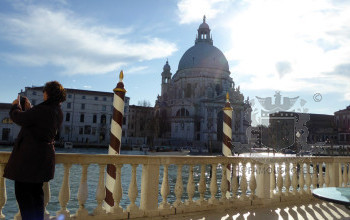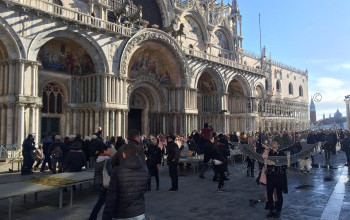Londra Palace: Tchaikovsky’s Lions
( words)
Our contributing editor and roving correspondent, ADRIAN MOURBY makes friends with two hotel lions and unearths the history of Venice's Londra Palace Hotel.
It's a minor footnote in hotel history that two life-sized statues of lions used to sit outside the Hotel Londra Palace on Venice's Riva degli Schiavoni. They are not winged Venetian lions like those that group around the statue of King Vittorio Emanuele II opposite the hotel but they are well-executed and even quite friendly in appearance.
What makes these lions significant is that the composer Piotr Tchaikovsky, a guest at the hotel in 1877, was sufficiently fond of them to contemplate calling his new symphony Do Leoni (Two Lions, in the Venetian dialect).
In December 1877 the 37-year-old Russian composer took rooms at Hotel Beau Rivage, a tall glamorous structure, one of a number of modern hotels overlooking the Bacino San Marco and which would one day become half of today’s Hotel Londra Palace.
The composer wrote enthusiastically of working on his fourth symphony in the hotel, recording that “Venice is a marvellous city. Every day I discover something new and fascinating. I believe I have fallen desperately in love with this charming maiden.”
The love affair did not last however. When the Venetian weather grew cold and damp, Tchaikovsky became gloomy and eventually left Riva degli Schiavoni without sketching the final movement of his fourth symphony. It never did bear the name Do Leoni.
Today Tchaikovsky’s sojourn at the Beau Rivage is commemorated by a large screen of frosted glass etched with his handwriting in the lobby of Hotel Londra Palace. Here those two lions now sit side by side indoors, rather as if they are waiting for the return of their Russian friend. The hotel has also named its restaurant Do Leoni and also created a bedroom – No 106 - in his honour. It’s decorated in rich reds and golds with a photo of the composer and various bits of copied memorabilia. (No one actually knows where Tchaikovsky stayed in 1877 so the Tchaikovsky room is more of an homage.)
It is also not known which room the poet Gabriele D’Annunzio occupied in 1887, when he was attended the unveiling of that monument to King Vittorio Emanuele II that had been built in front of the hotel. Or indeed where the novelist Jorge Luis Borges, who stayed here several times in the 1960s and 70s, laid his troubled head.

Hotel Londra Palace is one of those hotel puzzles that can be found all over Europe. It changed its name frequently as it enlarged and merged with other buildings and no one thought to keep a record of where the celebrity guests stayed as the hotel repeatedly changed hands. Much of what we do know about its history can be worked out from inspecting the facade of the building, which today overlooks the San Zaccharia vaporetto stop.
Hotel Londra Palace clearly consists of three structures that have been merged together over time.
What we do know is that in 1853 a new enterprise, the Hotel d’Angleterre & Pension was built on the quayside in front of San Zaccharia Church to designs by an architect called Rossini. In the days of the old republic it had not been permitted to construct commercial buildings in stone along the Riva degli Schiavoni but the success of Giuseppe Dal Niel’s new commercial hotel inside the old Palazzo Dandalo had encouraged speculative building nearby.
Danieli (as Dal Niel was nicknamed in Venice) had opened the hotel that would bear his name in 1822 on the first floor of the old Palazzo Dandalo. Its rapid commercial success had persuaded him to buy up the entire building in 1824 and restore it lavishly.
The Hotel d’Angleterre & Pension was built across the Rio del Vin from the Danieli. It took its name from the vogue for naming hotels with English place names. London, Bristol and Angleterre were fashionable trading names for Continental hotels in the nineteenth century.
Twelve years later (in 1865) another hotel, the Hotel Beau Rivage was built just a few metres away from the Angleterre by a Venetian engineer called Fuin. This taller, grander building, using Istrian marble in a Neo-Lombardesque style was to become Tchaikovsky’s home in Venice.
The two hotels were separated by a gap of a few metres and so could not be joined together as one enterprise until 1900 when they were merged to created the 73-room Hotel Londres et Beau Rivage. A small section of extra hotel was pushed into the gap in the style of the Beau Rivage to link the two buildings.
It is easy to work out that the less flamboyant Angleterre pension made up the right flank of the hotel and the Beau Rivage the left. The linking interstitial structure is only four windows wide with a recognisably different cornice. Moreover inside, on the first to fifth floors you’ll find some steps two-thirds of the way along each corridor at the point where lower floor level of the Beau Rivage meets the slightly higher floors of the Hotel d’Angleterre & Pension. An artist’s impression painted in 1900 gives a good illustration of how the join between the two hotels was supposed to be hidden by incorporating extra Gothic windows, giving the impression that old Beau Rivage had elegantly grown wider. There’s a lot of artistic licence in this picture however, particularly with the human figures which - not unusually for the time - were drawn half normal height to make the facade more impressive.
Sadly all those Gothic arches were swept away in the 1950s when the hotel given a consistent roofline. It is possible however to sit in Room 106 and imagine the views that Tchaikovsky would have had of the island of San Giorgio di Maggiore. He didn’t necessarily stay in this room but as just about every room at Londra Palace shares that view we can be fairly confident that this was the scene that inspired him.
One curious footnote for anyone researching the Hotel d’Angleterre & Pension/Beau Rivage/Londra Palace today is that it had a fourth name during the Fascist period when it was felt that “Londres” and “Beau Rivage” combined elements of two enemy cultures. So the hotel was renamed Bella Riva.The poster for that was even more fanciful, making the façade look like a palace on Lake Como.
Fortunately since 1973 when the Hotel Londra Palace came into being there have been no further name changes, which makes the life of the hotel historian so much easier.
What's in a name?
Sometimes too much!
© Adrian Mourby 2017
www.famoushotels.org











